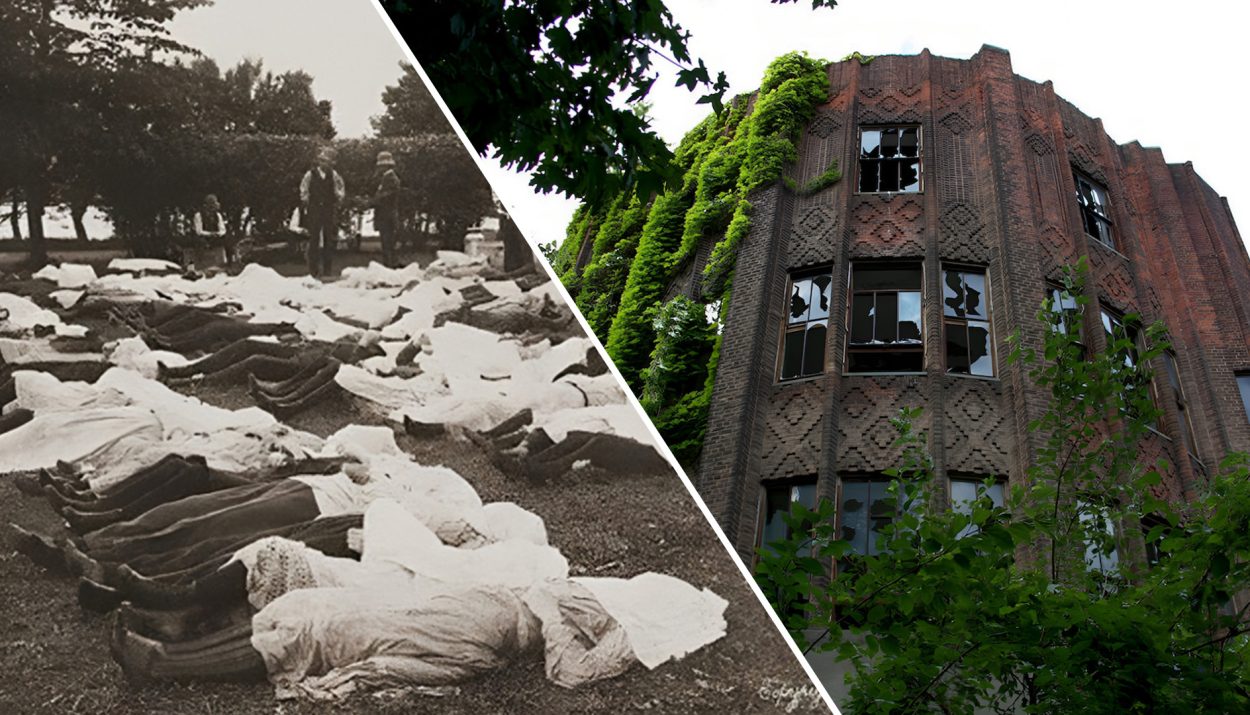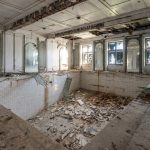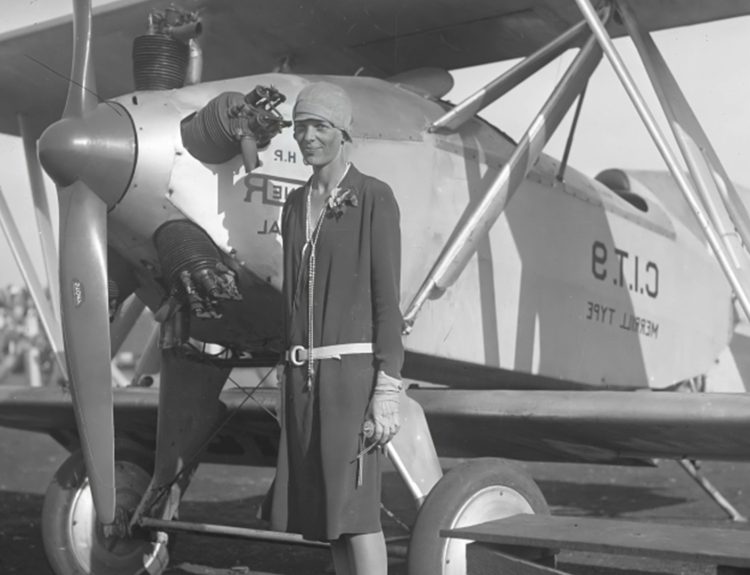It may seem unbelievable, but it’s true. This hidden gem is not your typical tourist destination, but it has attracted the attention of adventurous kayakers and urban explorers. Lets uncover the captivating story behind this eerie and mysterious place. Be prepared to be intrigued and amazed.
Decades of Neglect: The Tuberculosis Pavilion
Take a look at the Tuberculosis Pavilion Wing, added in 1941. Today, it stands in a state of disrepair, with broken windows and vines creeping up its walls. It’s astonishing to think that this very building, now neglected, was once a beacon of hope for thousands of people afflicted with tuberculosis.
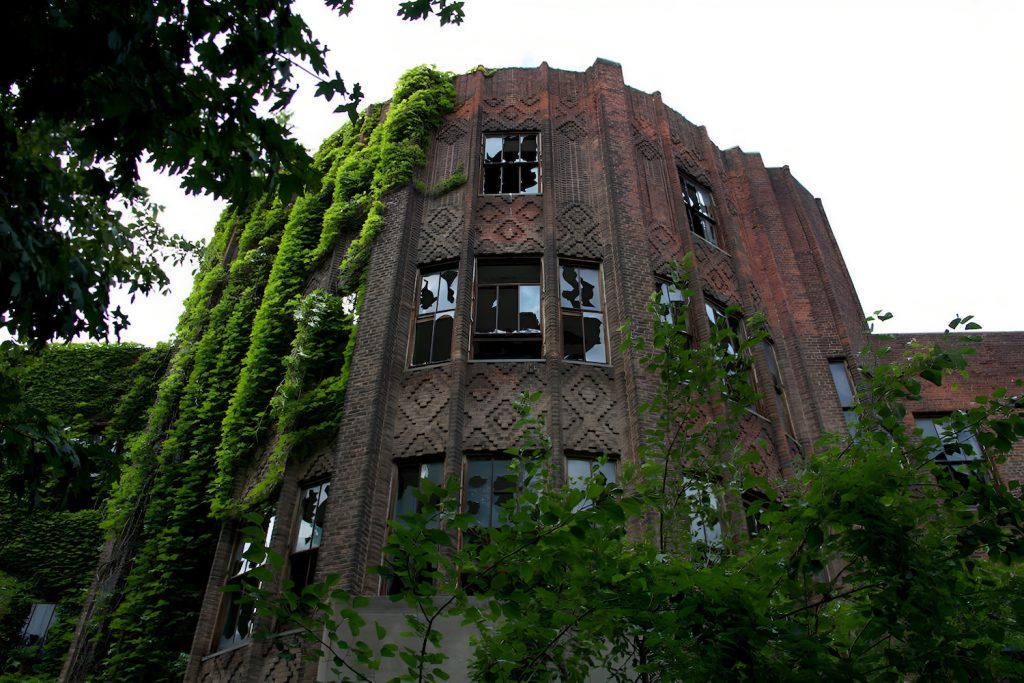
Quarantined within these quarters, victims of the disease endured one of the most arduous recovery processes in the field of medicine. The wing, once deemed essential, quickly became obsolete with the advent of vaccination programs and potent antibiotics. In a mere two years, the superstructure that housed these patients was shuttered, its purpose extinguished.
Time’s Unforgiving Mark – An Inside Look
As we take a glimpse at the devastating state of the pavilion’s walls, it’s hard not to be struck by the haunting resemblance to a war-torn battleground. The accumulation of dust, rust, and ancient furniture is truly remarkable, especially considering that this wing has remained untouched since 1945. The scene is a somber reminder of the passage of time and the neglect that has befallen this once pristine space.
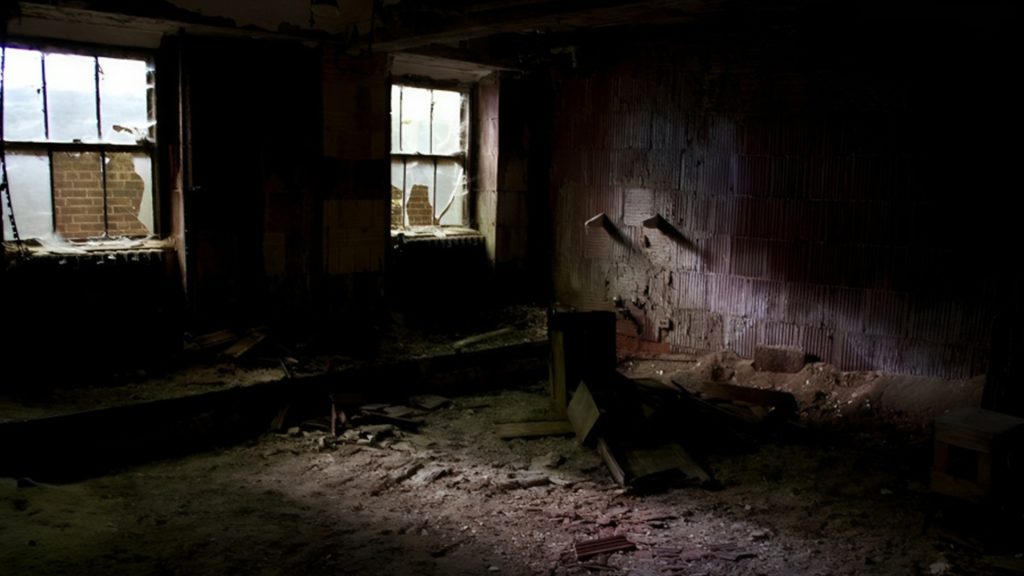
The abandoned location on the island has been a well-known secret among residents and tourists for years. What’s truly remarkable is the absence of graffiti on the foundation. Despite the broken windows caused by the relentless vines or occasional visitors, people have managed to maintain a respectful distance when exploring the site. It’s as if there’s an unspoken agreement to preserve the eerie beauty of this forgotten place.
Island Enshrouded in Haunting Mystery
In 1963, North Brother Island was left deserted. For almost 80 years, it had served as a facility for treating individuals afflicted with typhoid and smallpox. However, after decades of use as a sanitarium and rehabilitation center, the island was eventually abandoned.

Once a bustling hub with over 40 structures, including a hospital, church, and morgue, the island now exudes an eerie and haunting atmosphere. The air is thick with the scent of neglect, as rust, dust, and fossilized furniture from a bygone era dominate the landscape. Broken chairs, tattered books, and stained bathtubs filled with debris paint a vivid picture of the island’s forgotten past. As you explore, you’ll encounter broken windows and other remnants that leave you captivated and curious about the island’s history.
The X-Ray Room
Once used for x-rays, the pavilion’s first floor now houses a tranquil tile sanctuary in the medical wing. Surprisingly, the control room on the left shows less damage than anticipated, but the adjacent wall has clearly suffered significant impact.
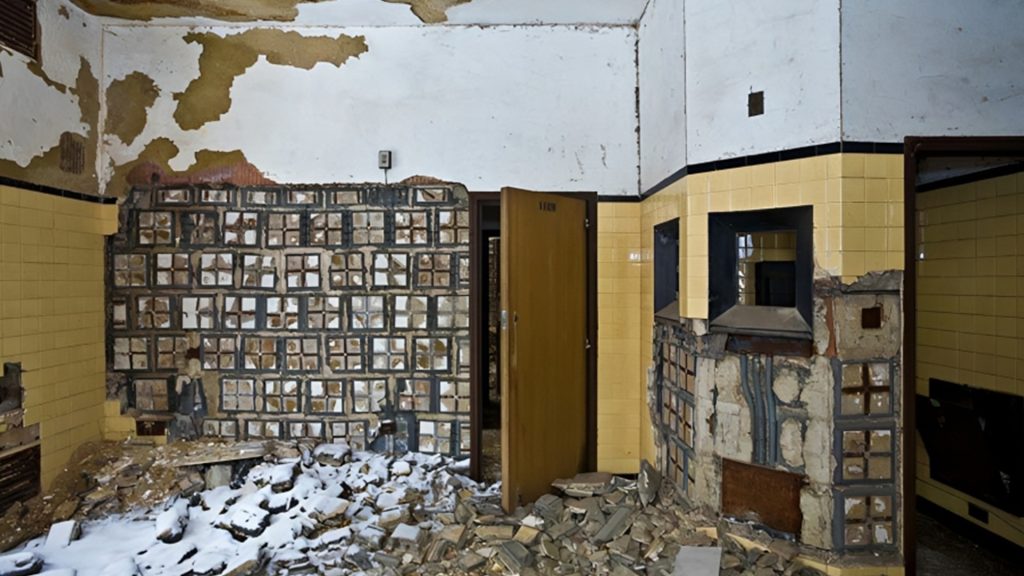
The ceramic tiles that once covered the walls have now been removed, revealing square lead blocks that line the exposed surface. The yellow tint that was once present has faded away, giving us a glimpse into the past. However, the upper walls and ceilings on the right side of the room show signs of water damage, which is unexpected considering the room’s overall condition. It’s a mystery how this room managed to stay intact over the years
A Ground Adorned with Roots Tells a 60-Year Story
Step into another room in the pavilion wing and you’ll find yourself surrounded by an intriguing “Earthy” texture that seamlessly blends with the natural beauty of the island. The ground is adorned with roots that burst through the cracks in the floor, creating a unique and unexpected sight. It’s hard to believe that all of this was nonexistent just over four decades ago.
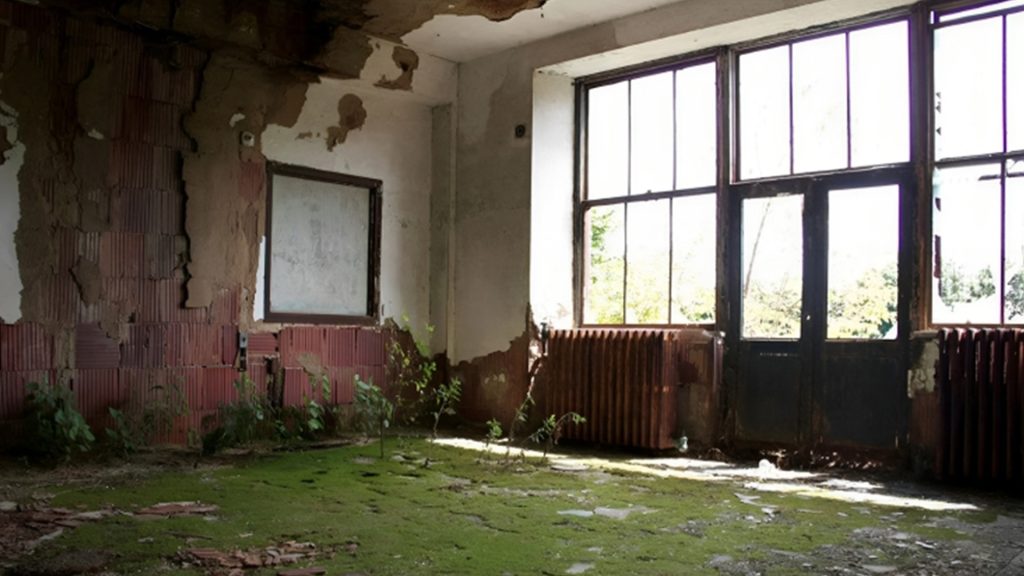
Witness the devastating destruction that has ravaged both the exterior and interior of the walls and ceiling. Just half a century ago, this wing was a beacon of hope, dedicated to healing and rescuing those afflicted by a relentless disease. Yet, today, we are confronted with a scene reminiscent of a lush garden, juxtaposed against the crumbling remnants of a once sturdy foundation that miraculously remains partially intact.
Desolate Auditorium: A Forgotten Stage
The auditorium in the North Brother “School” is a remarkable space that has stood the test of time, despite its deteriorating condition. This room, which was once a hub of activity for the island’s children and teachers, is now a haunting reminder of its former glory. The remnants of broken and decaying furniture scattered throughout the space serve as a poignant reminder of the lives that once filled this room.
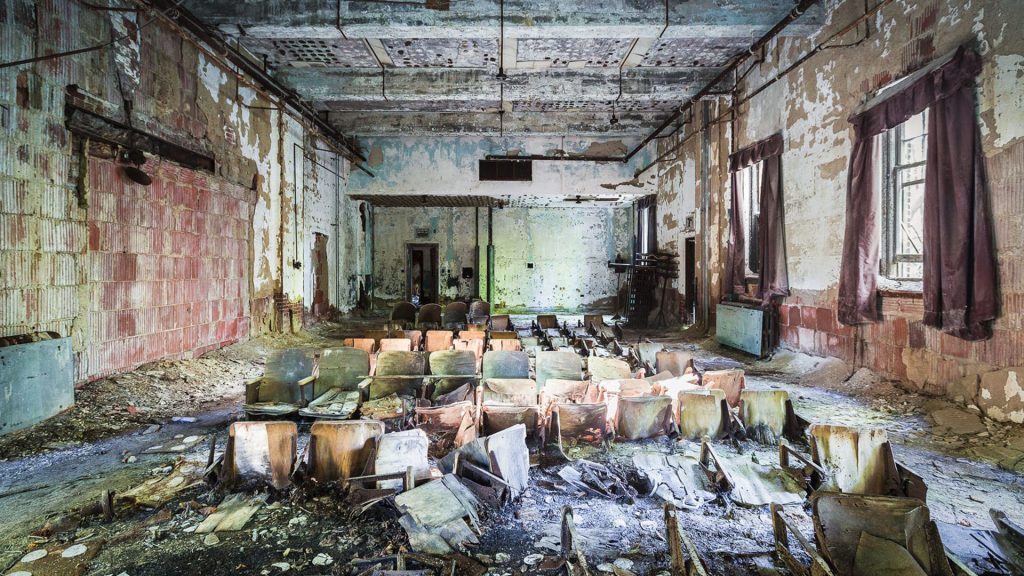
Imagine if the weathered walls of this chamber could share their secrets. They hold the untold stories of a place that was once a lifeline for countless sick children. This institution, now abandoned, played a crucial role in caring for those who called this island home. The corroded walls stand as a silent witness to the history that unfolded within their confines.
Unforgettable: A Tale Worth Remembering
The floors of this island are strewn with neglected books, their pages filled with forgotten and purposeless words. These books were once treasured by the island’s inhabitants, holding meaning and significance. Now, they lie abandoned, a testament to the passage of time. Take a look at the remnants of the children’s ward, transformed into a library and annex after the tuberculosis pavilion became a drug treatment center.

During the time when tuberculosis patients were quarantined on the island, they were closely monitored due to their highly contagious condition. This meant that they had to stay under constant supervision until they were completely cured. As a result, the children who were affected by the disease must have felt restless and in need of entertainment. It is not surprising, then, that this part of the island was transformed into a library, providing them with books as a means of escape and amusement.
Decaying, Lush Relics
This hidden gem was once the island’s second chapel, but you’d never guess it now. All that remains is a solitary wall, fragments of the floor, and a tree draped in a lush coat of moss. The chapel, constructed from wood, has all but vanished, consumed by the relentless march of the surrounding forest. It’s as if nature itself is reclaiming this sacred space, gradually engulfing the entire island.

In the midst of immense hardship and perilous circumstances, the resilient community of North Brother Island sought solace and hope in the form of faith and prayer. Despite its seemingly neglected appearance, the significance of the establishment cannot be underestimated, as it served as the lifeblood of the city. As we delve into the intriguing history of North Brother, it becomes clear that understanding its past is essential to comprehending its present state. So, let’s embark on a journey through time and explore the captivating story of this enigmatic island.
Unveiling the Birthplace of North Brother
During its operation, North Brother Island served as a quarantine for smallpox patients. Those affected with the contagious disease would be confined to the island until they were no longer a risk to others. In some cases, unfortunate souls who succumbed to the illness were laid to rest on the island. However, once patients had fully recovered, they were granted permission to leave the island and return to their homes.

Edward Jenner’s groundbreaking discovery of using cowpox to protect against smallpox led to the implementation of a global vaccination program. This program successfully eradicated smallpox worldwide. To contain the disease, infected individuals were isolated in a sanitarium on an island, where they received care from medical staff who had already overcome the illness. This approach effectively prevented the spread of smallpox within cities.
Unmasking Typhoid: Battling the Island Epidemic
Typhoid is a unique disease that, unlike smallpox, doesn’t claim as many lives. However, if left untreated, it can still be deadly, with a mortality rate of 10% or higher. This infectious illness is caused by a specific strain of bacteria known as salmonella typhi.
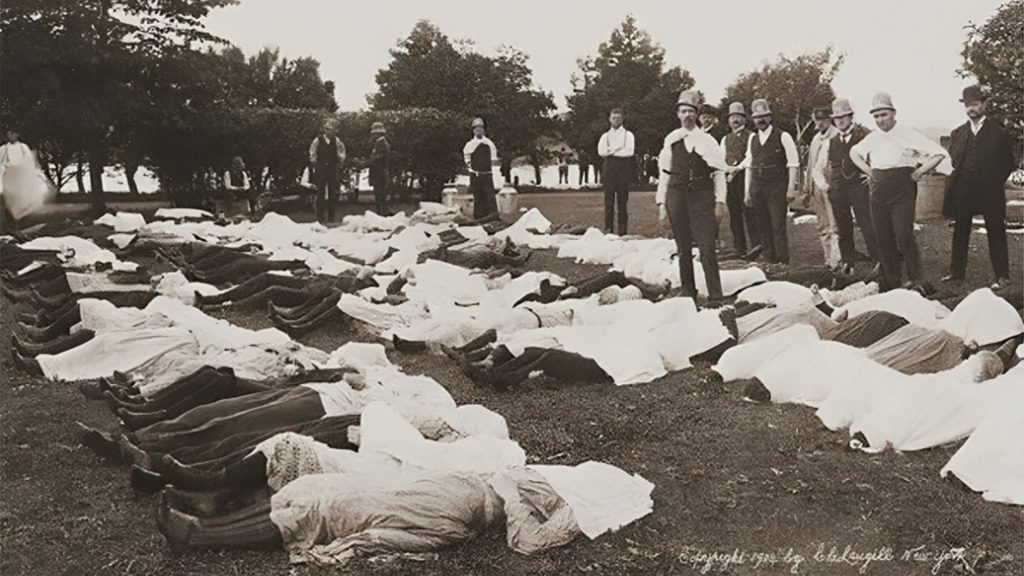
When someone contracts salmonella typhi, they typically experience symptoms such as fever, rash, and various complications. After about three weeks, the body’s immune system usually fights off the infection, and the person recovers. However, there are a few exceptional cases where individuals do not show any signs of illness when exposed to salmonella typhi.
Typhoid Mary: The Island’s Notorious Inhabitant
Mary Mallon didn’t fall victim to salmonella typhi. Instead, she unknowingly became a carrier of the disease without experiencing any symptoms. This meant that while Mary remained healthy, she had the ability to spread the infection to others, unknowingly passing on the illness.
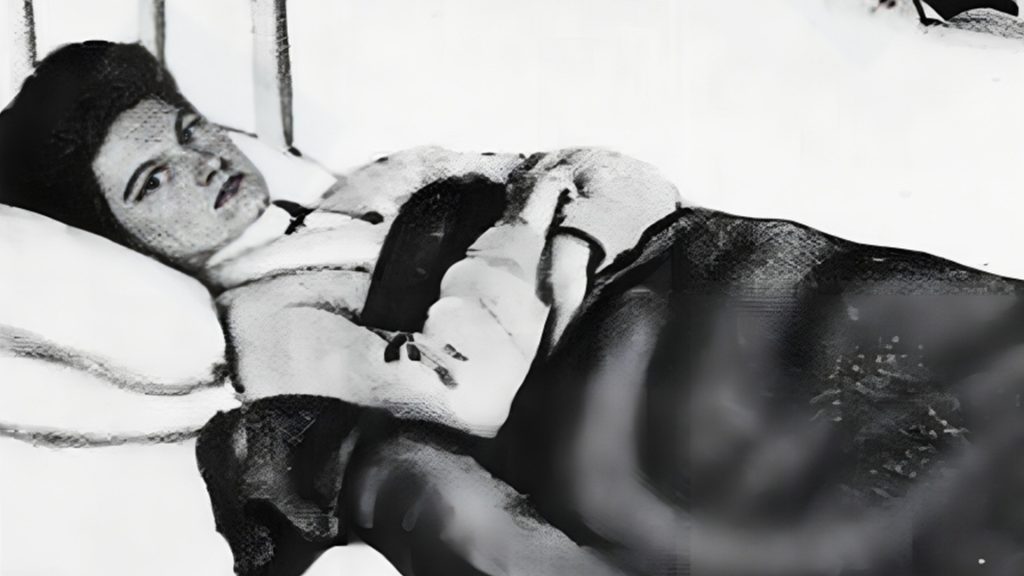
Imagine being known as “Typhoid Mary,” the woman who unknowingly spread disease to countless people in New York. Despite the evidence, she stubbornly denied her role in the outbreaks. As a result, she was forcefully isolated on North Brother Island for over two decades, all because she couldn’t give up her job as a cook. The story of “Typhoid Mary” is a chilling reminder of the power of denial and the consequences it can have on public health.
Typhoid Mary Meets Her Demise on the Island
Mary Mallon’s legacy is undeniably grim. Her stubborn denial of being a carrier of typhoid led to the deaths of at least three individuals, with potentially over 50 lives claimed by the infections she spread. The true extent of her impact on public health remains difficult to ascertain due to various challenges in tracking her cases.

In 1932, Mary, a dedicated technician on the island, suffered a debilitating stroke that rendered her immobile. Tragically, she succumbed to pneumonia in 1938. Surprisingly, during an autopsy conducted after her passing, scientists made a startling discovery – her gallbladder was still harboring live typhoid bacteria. This irrefutable evidence confirmed her status as a carrier, shedding light on the mysterious spread of the disease.
Tuberculosis: A Grave Concern
Tuberculosis, a grave illness addressed on the island, is a bacterial infection that ravages the lungs, leading to the deterioration of lung tissue. This contagious disease spreads through the air when infected individuals come into close contact with others.
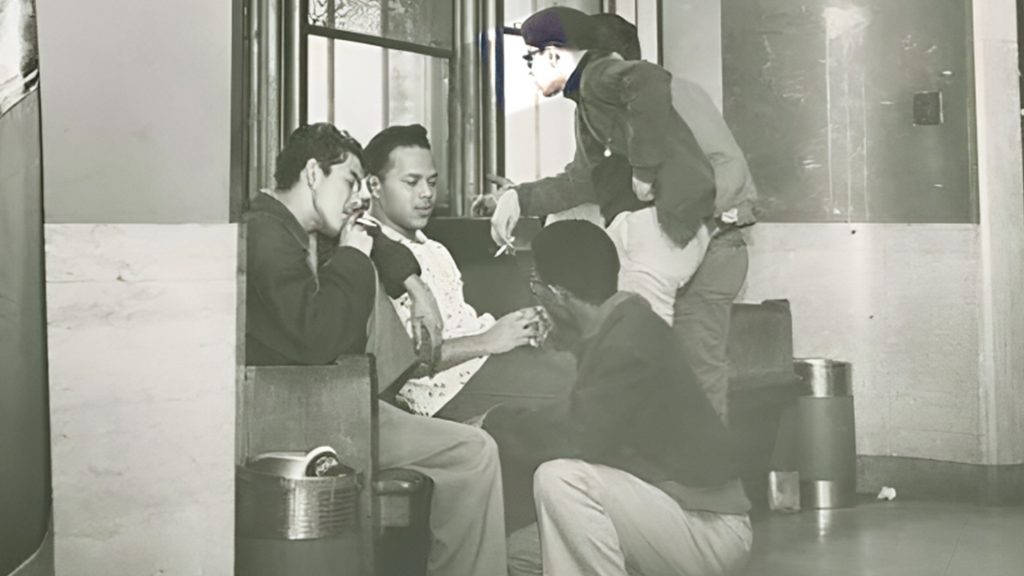
Despite the availability of a highly effective vaccine, tuberculosis remains a major health concern due to limited access to vaccination programs. This is especially true for individuals who smoke or have HIV, as they are particularly vulnerable to contracting the disease. While antibiotics can be used to treat tuberculosis, the rise of antibiotic-resistant strains poses a growing threat. Shockingly, in 2014 alone, almost 10 million people were diagnosed with tuberculosis, resulting in nearly 1.5 million deaths.
Beyond a Sanitarium: Unveiling the Unexpected
Towards the end of its existence, North Brother Island served a dual purpose – not only as a treatment facility, but also as a haven for service people and their families. One such example is the attic room that has managed to withstand the test of time, preserving a glimpse into the lives of those who called the island home.
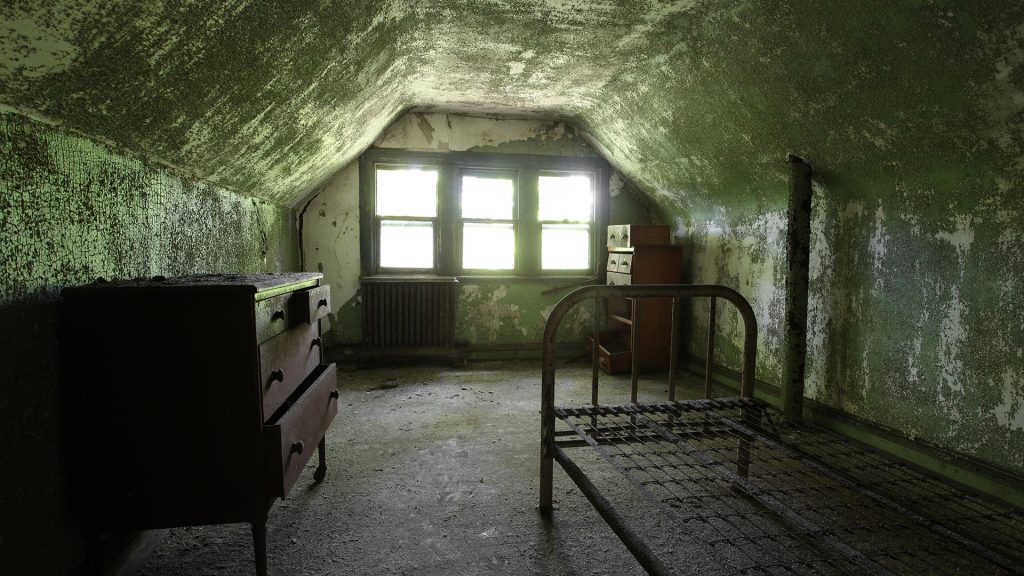
After the devastating impact of World War II, many war veterans faced hardships and challenges. In response, North Brother Island, originally built to combat diseases, was repurposed to provide housing for those in need. Imagine a picturesque island, with its winding roads, lush lawns, and bustling buildings, where families found solace and a fresh start in their new New York home. It became a haven, offering essential facilities and a sense of community to those who had endured so much.
The Era’s Demise: A Definitive End
In the 1950s, North Brother Island started to lose its appeal. The residents found it inconvenient to live on the island while working in bustling New York City. The irregular ferry service made commuting a challenge, leading to a decline in the island’s population.
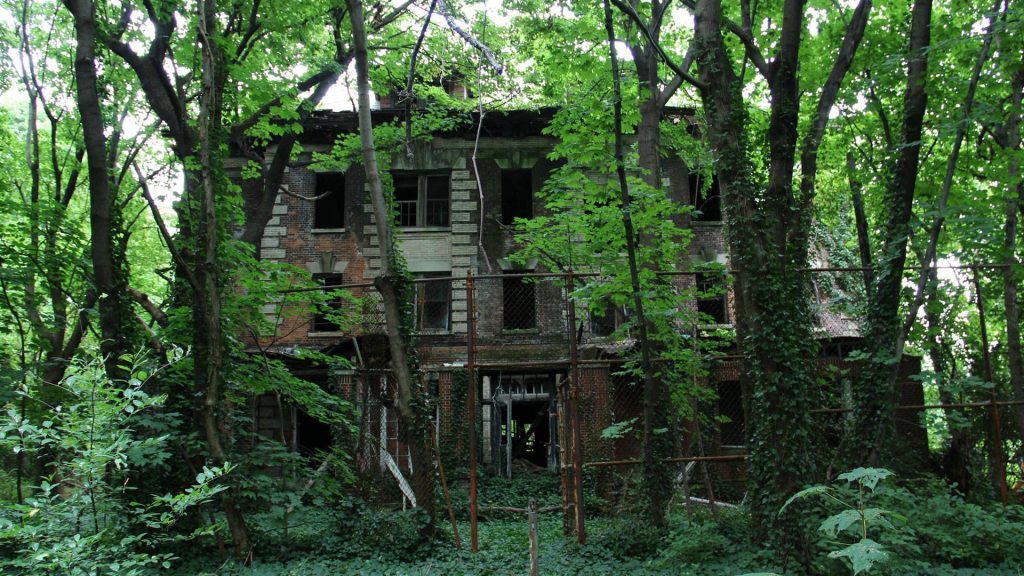
In contrast, the city had a different perspective when it came to North Brother Island. They were primarily focused on the financial burden of maintaining the island. At the time, there were plenty of affordable properties on the mainland, and the city was already providing financial support for the ferry service. As a result, they made the decision to relocate the remaining families and patients in heroin rehabilitation back to New York City and leave the island to be reclaimed by nature.
Island Buzz: What’s Happening Today
Now, let’s fast forward 40 years and imagine a scene where lush vines have taken over the once bustling island, slowly reclaiming the abandoned buildings. This island, once a vibrant hub of activity, had been left forgotten for quite some time. However, in the 70s, it experienced a resurgence of sorts, becoming a popular destination for boating enthusiasts. Unfortunately, this newfound attention brought with it some acts of vandalism, resulting in damage to the 26 individual foundations that can still be found on the island.
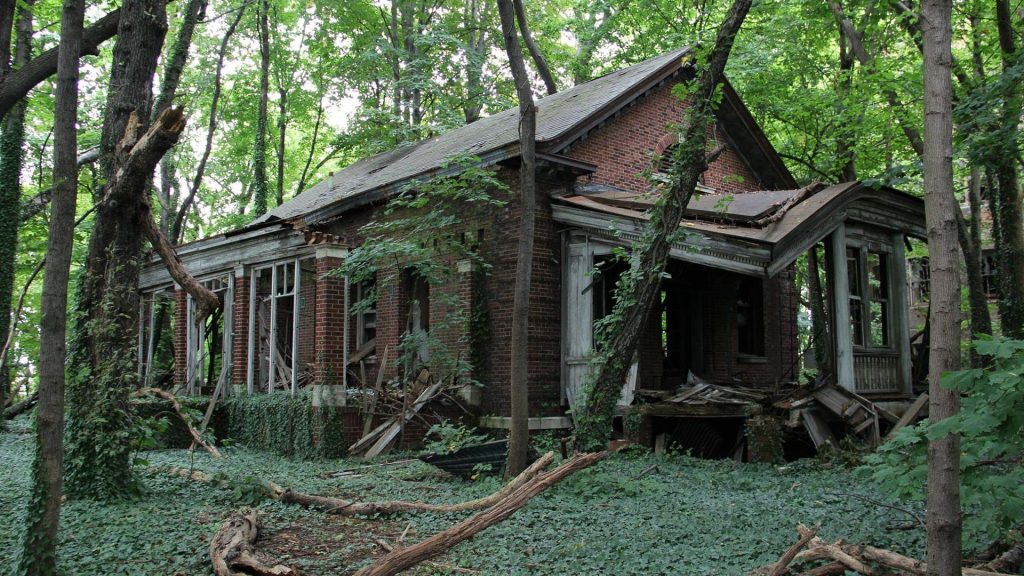
Over the past decade, Governors Island, along with 17 other nearby islands in New York, has become a crucial breeding ground for Weather Birds, thanks to the efforts of the New York City Audubon.
Tragedy Strikes: The General Slocum Disaster
Beyond the devastating toll of diseases like Typhoid and Smallpox, North Brother Island harbored a dark secret. It bore witness to a horrifying and inexplicable accident that claimed the lives of more than 1,000 individuals.
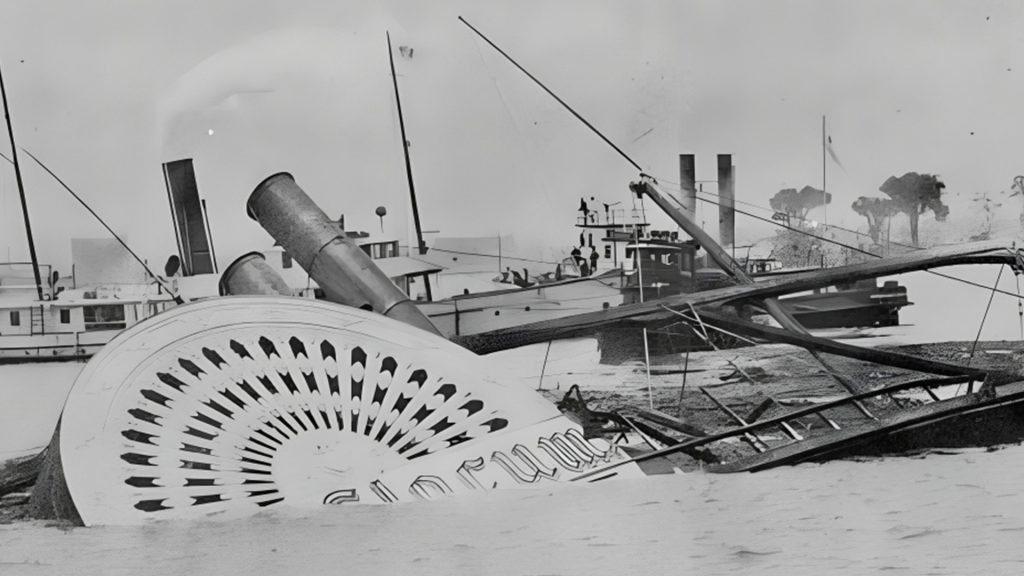
Picture this: June 15, 1904. The PS Slocum, a charming sidewheel passenger ship, was all set for a delightful excursion. The St. Mark’s Evangelical Lutheran Church had chartered the vessel for a mere $350.00, offering a day of adventure and joy to the passengers. On board were mainly women and children from the vibrant German-American community of the Lower East Side, eager to escape the hustle and bustle of the city. Their destination? The serene North Shore of Long Island. Little did they know, their journey would take a tragic turn, leaving them stranded and forever changed.
Tragic Blaze Engulfs General Slocum
As the PS Slocum sailed up the East River, disaster struck with alarming speed. While the exact cause of the fire remains unknown, what we do know is that within just thirty minutes of departing the dock at around 9 a.m., the flames had engulfed the ship. The majority of the passengers found themselves in a terrifying predicament, unable to swim and faced with the grim choice of burning or drowning.
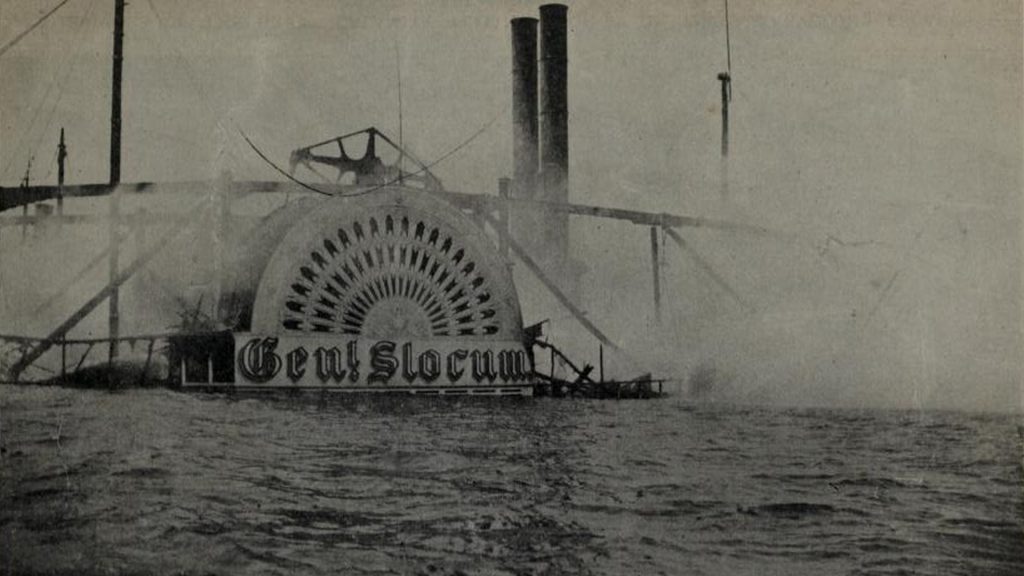
Despite Captain William Henry Van Shaick’s efforts to steer the ship towards North Brother Island, it was too late to save everyone. Out of the 1,358 passengers on board, only 321 would survive. The final death toll reached a staggering 1,021, with many of the bodies washing up on shore in the following week. This tragic event stands as one of the deadliest in U.S. history, surpassed only by the devastating events of 9/11.
The Devastating Fallout from the General Slocum Catastrophe
Captain William Henry Van Schaick was blamed for the accident, with reports suggesting that he intentionally didn’t bring the ship to shore due to insurance concerns. Onlookers were puzzled as they witnessed the burning ship just off the shore, wondering why Van Schaick didn’t turn around and dock the ship. Instead, he chose to sail it to North Brother Island, citing the danger of docking near gas tanks and lumber yards at 130th Street, where the boat was ablaze.

Van Schaick was found guilty of criminal negligence for failing to conduct the required fire drills. As a result, he was sentenced to 10 years of hard labor, although he only served a portion of his sentence at Sing Sing prison. Ultimately, President William Howard Taft granted him a pardon in 1911.
The Nurses’ Home
The Nurses’ home boasts a remarkable cast iron staircase that still stands today, adding a touch of elegance to its architectural design. This staircase, spanning three floors, serves as a connection within the oldest section of the building. However, despite its historical charm, the Nurses’ home has gained a reputation for being one of the eerie structures on the island. During a visit in 2011, Radiolab discovered something unsettling lurking within the decaying walls.

While nature has reclaimed parts of the building, evidence suggests that humans were present in the not-so-distant past. Bullet holes riddle the outer door, but these were not caused by entry shots. Instead, they indicate that someone was fired upon from inside the nurses’ home. The circumstances surrounding this incident remain shrouded in mystery, leaving us to wonder what exactly took place within those haunted halls.
Vicious Vines Menace Bird and Tree Populations
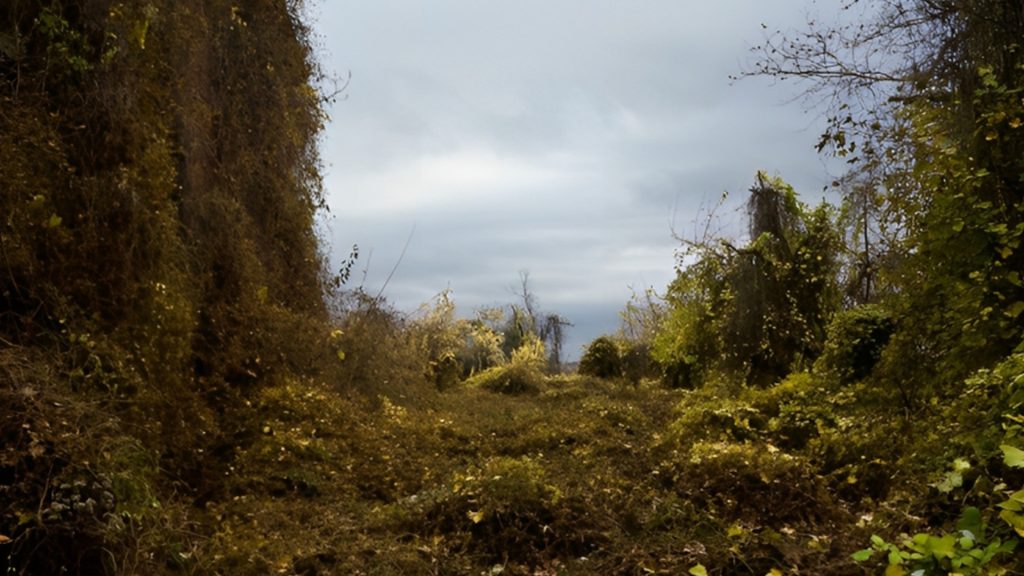
The Nurses’ home on the southern side is almost invisible beneath the thick blanket of vines that cover its walls. The encroachment of nature, however, poses a threat to both the building itself and the delicate balance of the island’s ecosystem. The invasive kudzu vine, not native to the area, has taken hold and is causing structural damage to the building. But the bigger concern lies in the suffocation of native trees and the disruption of the herons’ habitats and breeding patterns. The battle between nature and human structures is a complex one, with consequences that extend far beyond the surface.
Uncovering Hidden Treasures: Exploring the Maintenance Building’s Odds and Ends
One of the intriguing aspects of uncovering a forgotten world lies in the minute details that offer glimpses into the past. In the image provided, a collection of keys used to unlock different buildings on the island can be observed. These keys were discovered in a maintenance building, which still contains an assortment of odds and ends.

The effects of chemicals on the structure are evident, as seen in the altered appearance of the building. Adjacent to the keys, a chemical stalagmite has formed, adding an eerie touch to the scene. Within the maintenance room, an incredibly well-preserved phonebook from ages past can be found. The phone numbers listed in the book are a stark contrast to the format we are accustomed to today, serving as a reminder of how much communication technology has evolved over time.
Abandoned Tuberculosis Pavilion: A Wasted Opportunity for Patients
North Brother Island gained notoriety for its association with Typhoid Mary, but not all of its buildings served their intended functions. One such example is the Tuberculosis Pavilion, which was constructed in 1941 but never actually treated any patients with the disease.
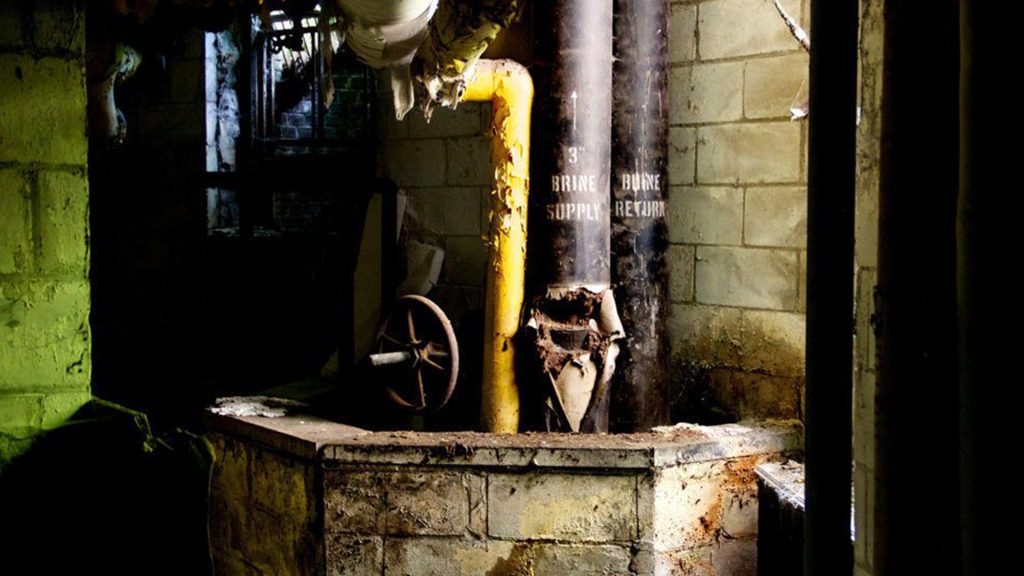
Before it could be utilized, the island was abandoned, and individuals suffering from tuberculosis were relocated to other municipal facilities. Instead, the tuberculosis hospital was repurposed as a dormitory and later transformed into the primary residence and treatment facility for Riverside Hospital’s rehabilitation program.
Unmasking the Dark Secrets of North Brother Island’s Addiction Crisis
The tuberculosis building, originally intended for tuberculosis patients, ended up serving a different purpose at Riverside Hospital. Instead, it became a facility for the hospital’s juvenile substance abuse treatment program. However, it quickly became apparent that the building was ill-suited for rehabilitation. Many of the doors were transformed into seclusion rooms, fortified with heavy deadbolts and sheet metal. These rooms were used to isolate individuals going through withdrawal, a harsh and solitary experience.
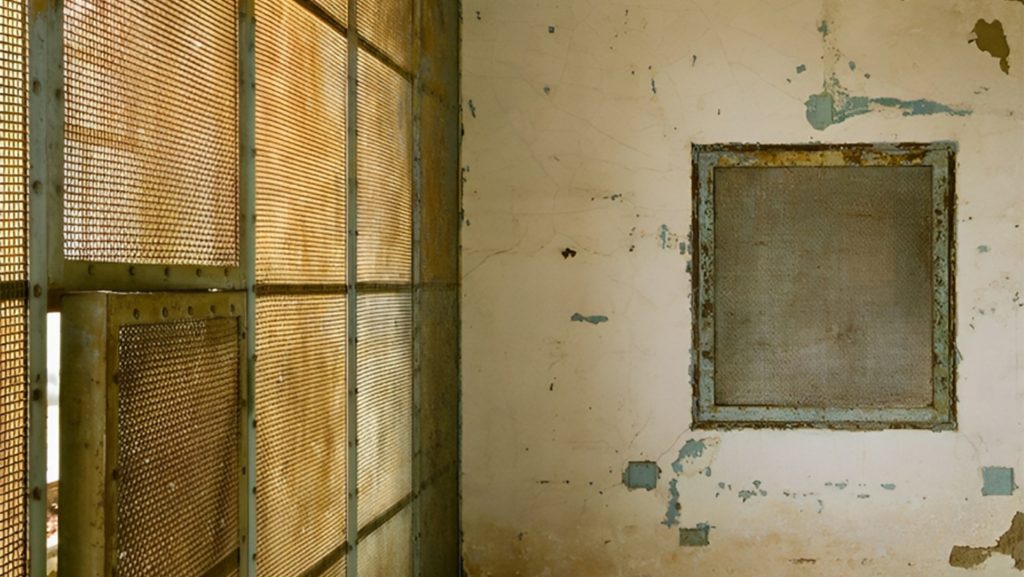
Within the confines of the seclusion rooms, addicted patients were left with minimal provisions – just a bare mattress and a mess bucket. They were forced to endure the grueling process of withdrawal in isolation, without any medication unless their condition became life-threatening. After enduring several days of agonizing withdrawal, they were released back into the general population, ill-prepared to face the challenges of sobriety. This unorthodox approach to treatment left many questioning the effectiveness and ethics of the program.
Revamping The Island: A Game-Changing Approach to Addiction Treatment
Keeping a recently clean addict in the general population doesn’t provide much support for their journey to sobriety. Riverside Hospital recognized this and made the decision to keep patients on the island for a minimum of 90 days. This allowed for a more effective treatment approach and increased the chances of long-term recovery.
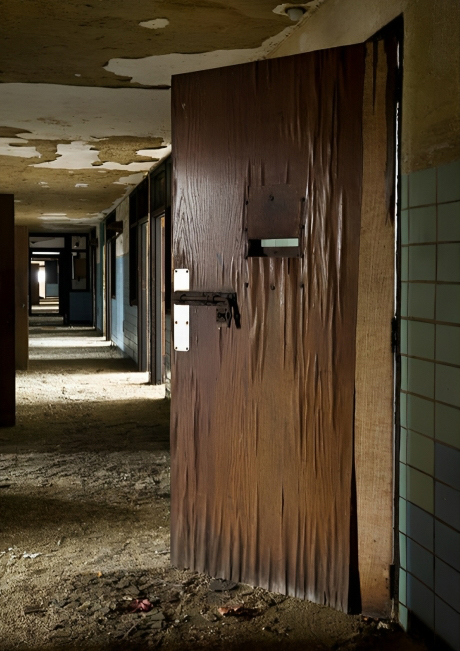
To accommodate the juvenile addicts, the hospital made significant changes to the buildings on the island. The services building was transformed into a school, providing education for the patients. The nurses’ house was converted into dormitories for the girls, while the original children’s ward, located near the tuberculosis pavilion, became a library and an extension of the school. These alterations created a more suitable environment for the patients to receive the care and support they needed.
Island Still Plagued by Substance Abuse Issues
The founders of the rehab program had high hopes for the newly constructed buildings, believing that they would greatly improve the success rate of treatment. However, their optimism quickly faded when they discovered that relapse rates were shockingly high. To make matters worse, it was discovered that patients were actually using narcotics on the island and even inside the hospital where they were supposed to be receiving treatment.
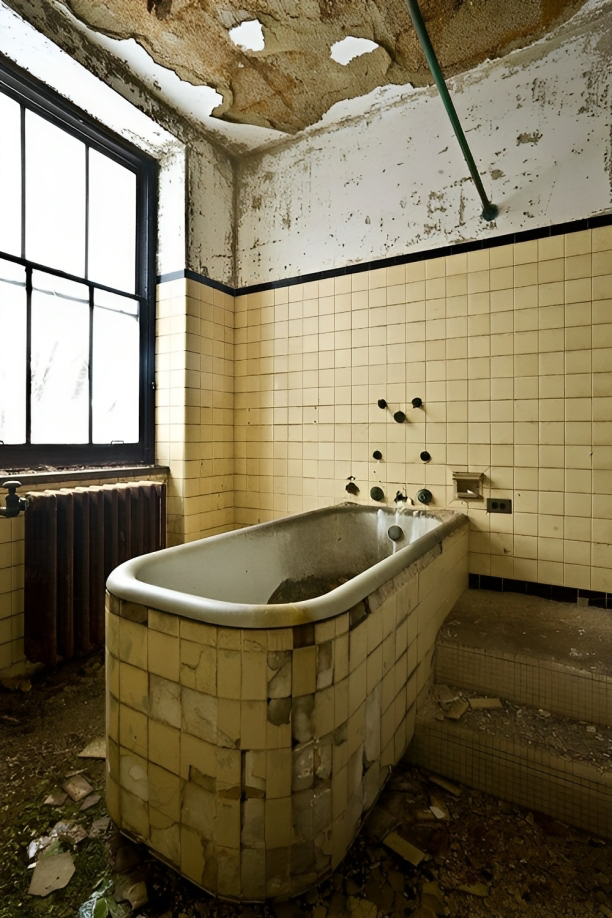
Disturbing reports emerged of people sneaking onto the island under the cover of darkness to smuggle in goods for their friends and loved ones in rehab. Additionally, there were accounts of orderlies engaging in illicit activities, such as bringing substances onto the island via the ferries in exchange for cigarettes. To add to the chaos, there were numerous instances of abuse occurring among the patients themselves. The situation became so dire that the decision was made to completely shut down Riverside.
The Morgue: Unveiling the Secrets of the Silent Sanctuary
The refrigeration room in Riverside Hospital’s morgue was once used to store bodies. Interestingly, this room was also where Typhoid Mary, who studied to become a pathological assistant in the same building, was examined after her death. It was here that doctors confirmed the presence of live typhoid cultures in her gallbladder.
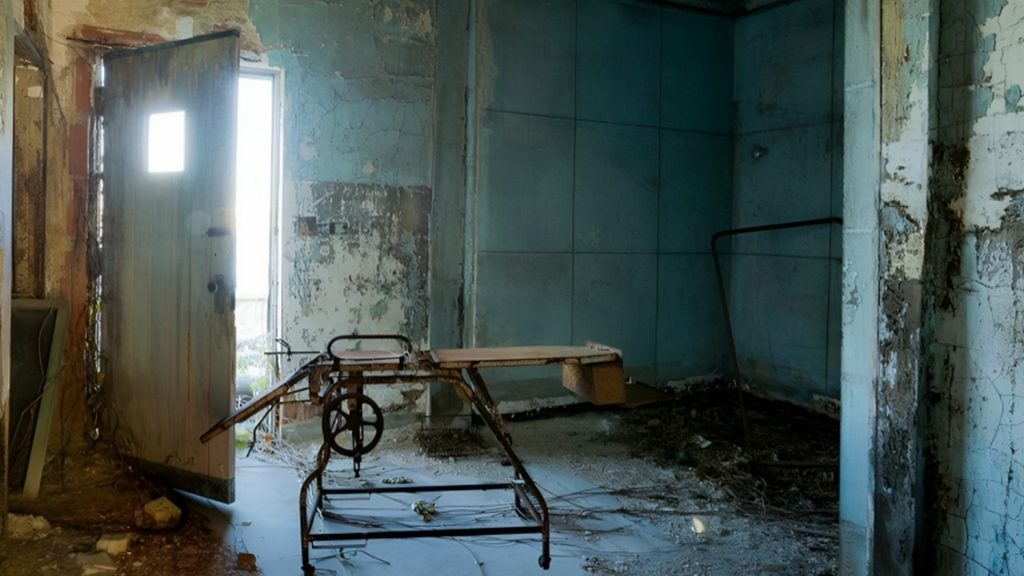
Adjacent to the physical plant, the morgue’s exterior has remained remarkably well-preserved. Unlike most morgues that utilize individual cabinets for each body, this one had an entire refrigeration room. The table shown in the picture is an examination table, not an autopsy table, adding to the unique features of this historic space.
One Ring to Rule Them All
The room before us once served as a bustling recreation center, now reduced to a decaying shell. The basketball hoop, suspended from the ceiling, dangles precariously, a testament to the vibrant games that once took place here. It’s evident that this was once a full court, with another hoop standing defiantly on the opposite side.
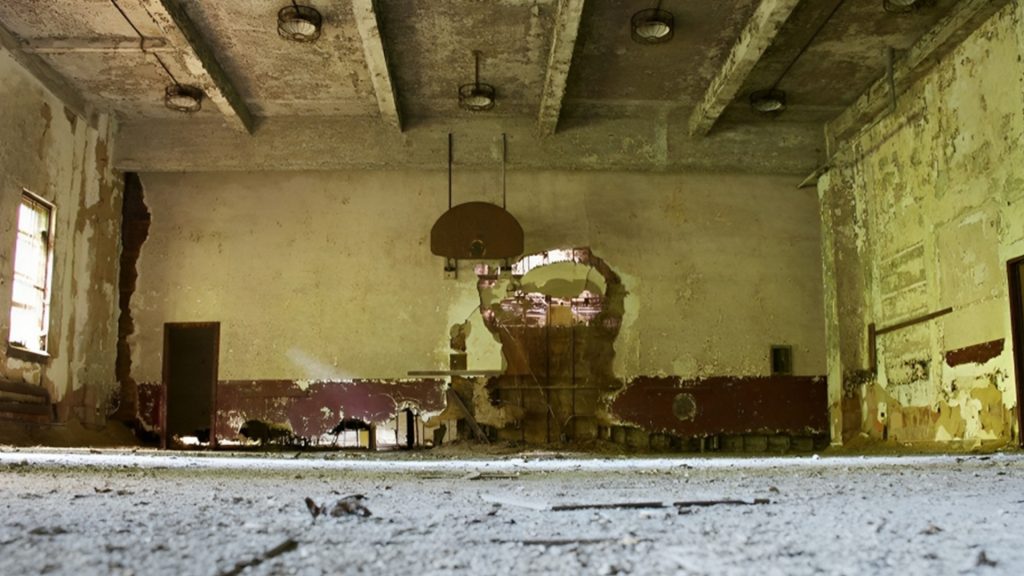
The staff had high hopes that fostering an athletic environment would provide solace and support for the addiction-plagued community. Just beyond the gaping hole in the gym’s wall, the lavatory stands, its dilapidated state hinting at the extensive water damage it has endured throughout the years.
Patients Forced into Captivity
In the abandoned tuberculosis pavilion, a chilling discovery was made. Deeply etched into one of the walls of a seclusion room was a distressing message: “Help I am being held here against my will.” It is believed that this desperate plea was written by a patient struggling with drug addiction, who was confined to the room to endure the agonizing process of withdrawal. This sentiment of resentment towards the facility was not uncommon, as many patients harbored a deep dislike for their confinement.
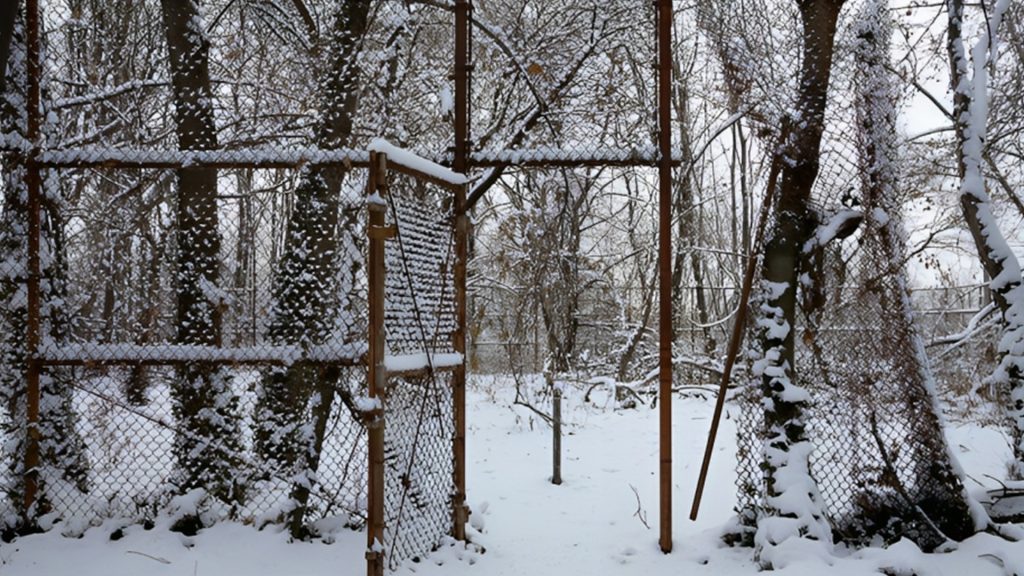
Regardless of the specific ailment they were being treated for, whether it be typhoid, smallpox, tuberculosis, or drug addiction, almost all the patients shared one thing in common – a strong desire to escape. These individuals were grappling with diseases that carried significant social stigma, and as a result, they found themselves essentially imprisoned on an isolated island. The sense of confinement and longing for freedom was palpable among these patients, making their stay at the facility a deeply challenging and distressing experience.
Boys’ Dorm
The boys’ dormitory, constructed in 1855 by renowned architect Charles Coolidge Haight, stands as one of North Brother Island’s oldest structures. Despite the ravages of time, this historic building has managed to maintain its structural integrity, with its sturdy brick walls still standing tall. While the windows have succumbed to the forces of nature, the dormitory remains a testament to the island’s rich past.
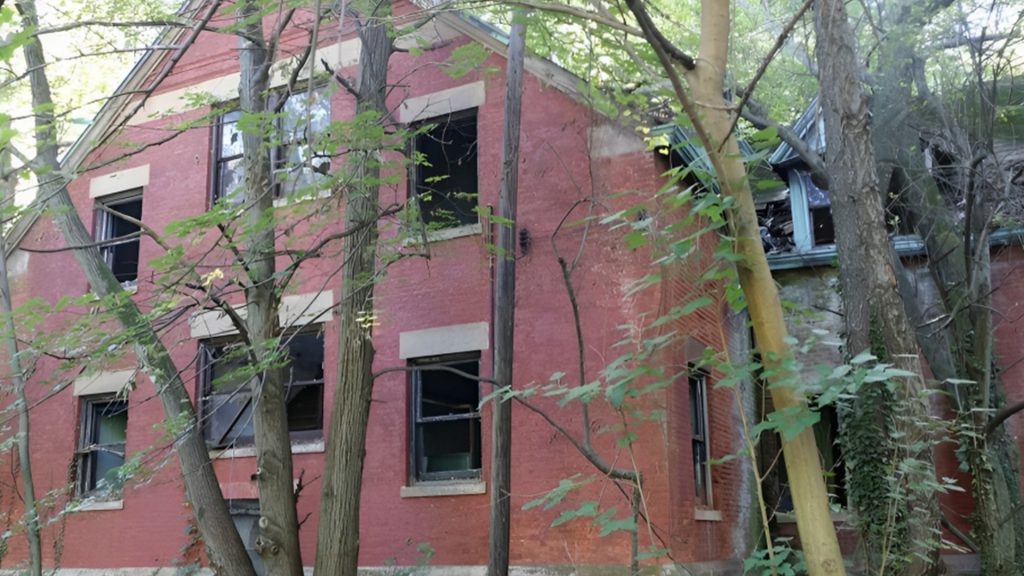
Looking ahead, city officials are considering restoring the boys’ dormitory, among a few other buildings, to transform North Brother Island into an educational hub. With aspirations to create a space for students and visitors to delve into the history and ecology of New York City, the island holds the promise of becoming a captivating destination for learning and exploration.
Where are all the Docks?
North Brother Island, a once bustling city, now sits abandoned and inaccessible to the public. The lack of docks makes it nearly impossible to reach this mysterious place. However, it wasn’t always this way. In its heyday, a towering gantry stood proudly, lifting cargo off boats and delivering much-needed supplies to the island. Can you imagine the hustle and bustle of a fully functioning city, complete with cars, roads, and even tennis courts? It’s a stark contrast to the eerie silence that now engulfs the island.
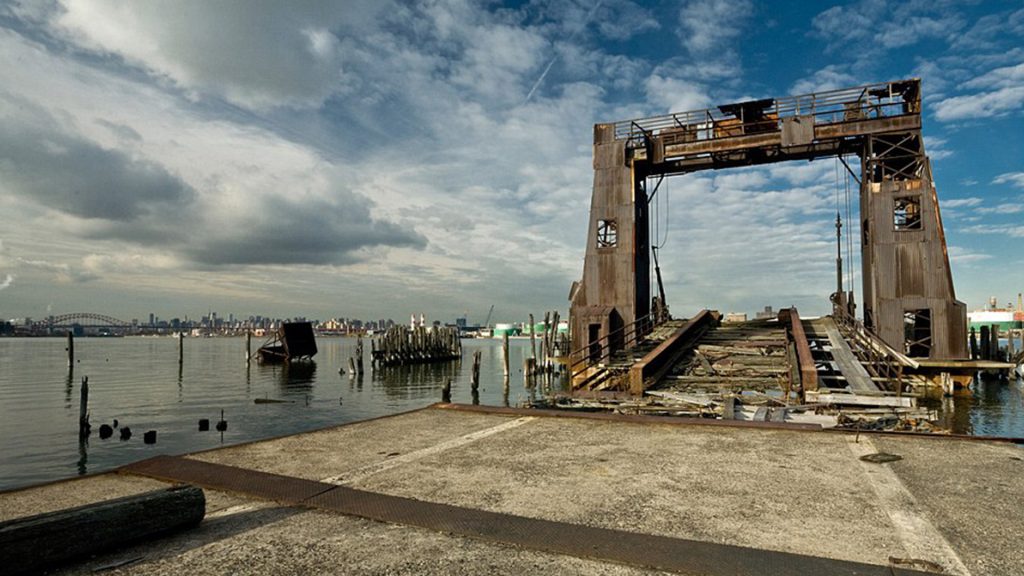
City officials are considering the addition of a new boat landing as part of their efforts to restore the island. This move is aimed at attracting tourists to the area. Currently, boats are simply tied to old pilings near the abandoned crane that was once used for transferring goods.
Smokestacks: When Disaster Strikes
Among the dilapidated structures on the island, the brick buildings still display their resilience, despite the surrounding decay. However, the smokestacks tell a different tale. A striking incident in the late 1990s caused the larger smokestack to lose several feet of bricks, which tragically damaged the morgue’s roof. As a result, the smokestacks from the boiler room pose a significant risk to any adventurous souls who dare to explore this eerie place.
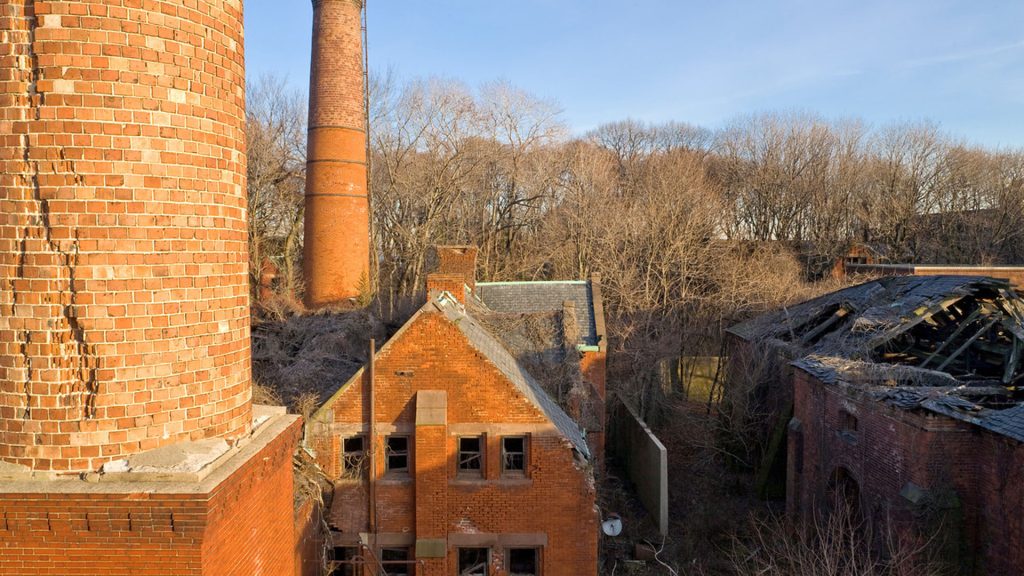
These buildings are in a constant state of disrepair, with bricks falling off and rendering them completely unstable. John Krawchuk, the executive director of the city Parks Department’s Historic House Trust, reveals that some of these structures have even collapsed in recent years. It’s clear that these buildings are in dire need of attention and restoration.
Electricity on the Island
North Brother Island, a secluded oasis in the midst of bustling city life, functioned as a self-contained metropolis. It relied on external sources for sustenance, with supplies arriving by boat and water flowing through a pipeline. Yet, despite its isolated location, the island thrived, boasting its own power generation capabilities, complete with steam, electricity, and even an internal telephone system. Safety was also a top priority, as an electrical fire alarm system was put in place to ensure the well-being of its inhabitants.
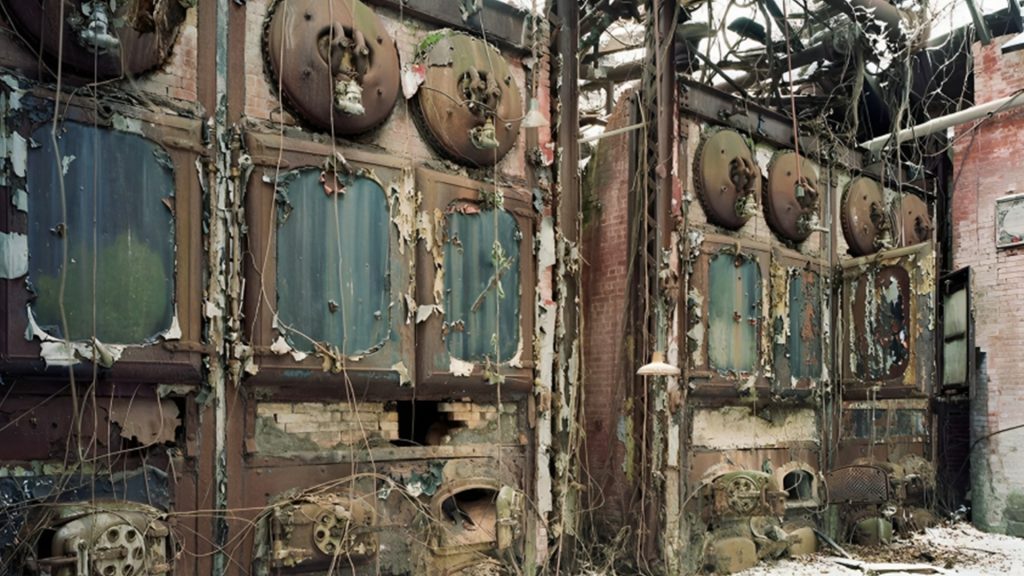
The physical infrastructure of the island played a crucial role in making all of this possible. The plant, located south of the island, was powered by coal, which was stored in a dedicated building nearby. To ensure a seamless supply of coal, a separate dock was constructed specifically for importing it onto the island. This efficient system allowed for quick and convenient access to the necessary fuel.
The Coal Building
The colossal structure that once housed the island’s sole energy source, coal, still stands today in all its grandeur. Situated to the south of the physical plant, this building was home to towering two-story boilers that generated power by incinerating coal.
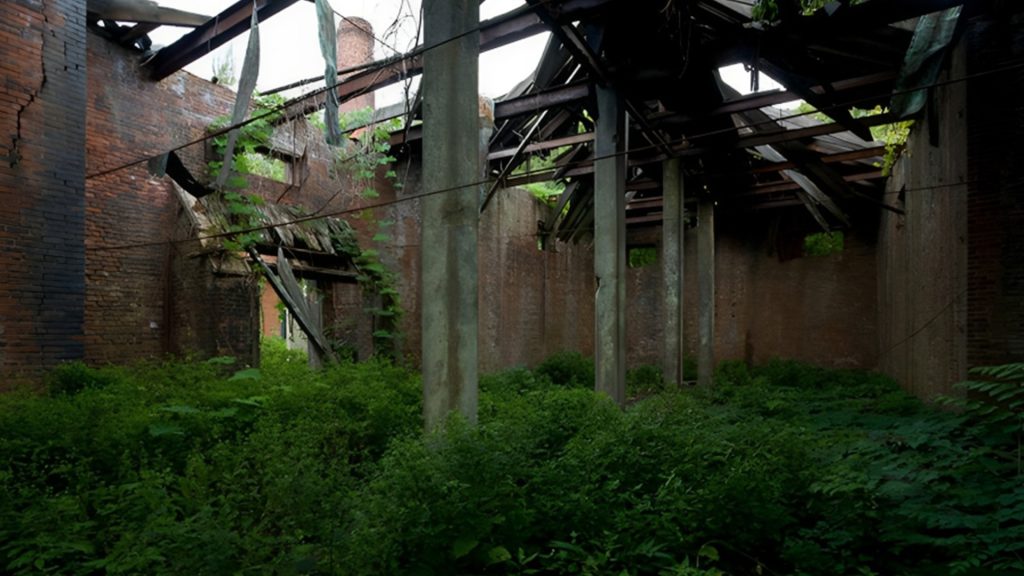
The coal building’s roof has crumbled, revealing a captivating scene below. The floor, now adorned with lush ferns and vibrant vegetation, resembles an ancient ruin. However, it’s important to remember that this structure was once at the forefront of technological advancements. Surprisingly, its abandonment only dates back to the 1960s, making it a relatively recent piece of history.
Exploring a Plethora of Historic Restoration Ideas in the City
Over the years, there have been numerous discussions about the potential uses for the island. In 1964, the city ceased using it as a drug rehab facility and it was left abandoned, presenting a range of possibilities. Mayor John Lindsay advocated for selling the island, while Mayor Ed Koch briefly considered the idea of establishing a homeless shelter there.

During the 1990s, there was a proposal to construct a jail as an extension of Rikers Island. However, the high cost of both building and maintaining the facility proved to be a major deterrent. This option, like the others, was deemed financially unsustainable.
Revitalizing Restoration Strategies
Councilman Mark Levine is determined to make North Brother Island more accessible, recognizing its historical significance and diverse ecosystem. Since 2016, he has been leading a campaign to expand access to the island. To further explore this possibility, Penn Praxis, an affiliate of the University of Pennsylvania’s School of Design, is currently conducting a study.
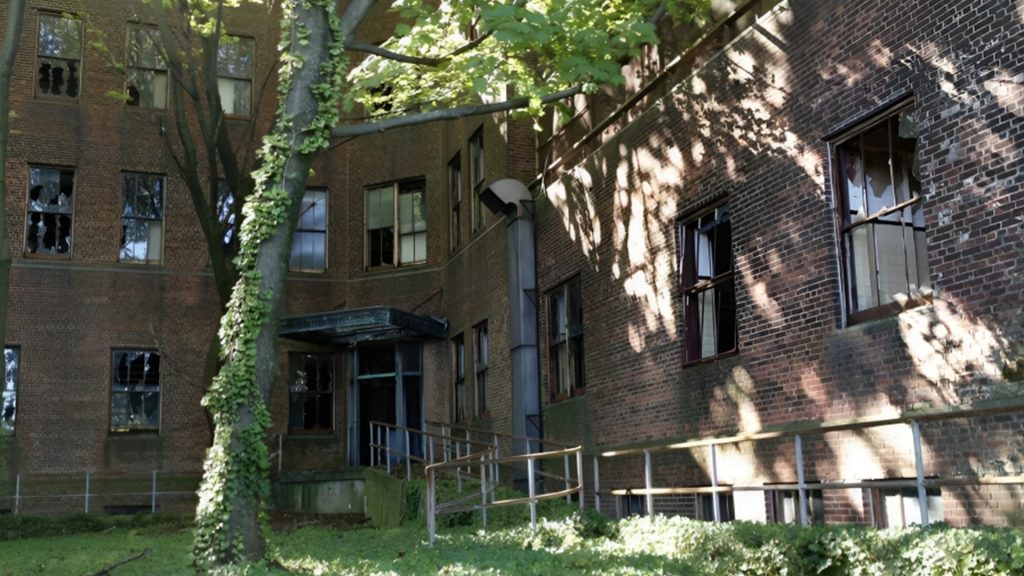
Restoring the property poses a significant challenge due to the high costs involved. Allocating funds for staffing, maintenance, and management is a daunting task, especially considering the limited budget of the city’s Parks Department. The logistics of this endeavor are still up in the air, leaving uncertainty about the feasibility of the restoration project.
Urban Exploration Continues to Draw Adventurous Souls, Ignoring Legal Consequences
Visiting North Brother Island is strictly forbidden, but that doesn’t stop adventurous urban explorers from finding their way there. Despite its abandonment, remnants of human presence can be found amidst the island’s untouched landscape. A weathered chair, positioned to take in the breathtaking view, serves as a reminder of past visitors. Empty cans of Heineken beer and other discarded trash, along with graffiti adorning the walls, provide glimpses of contemporary influence on this forgotten island.
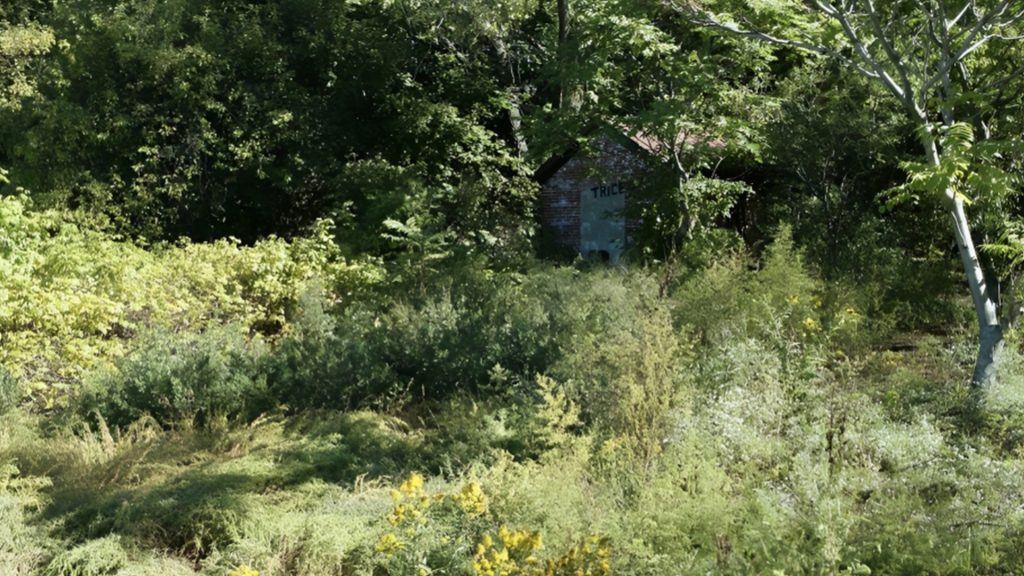
The island’s current state poses a challenge for navigation due to the presence of poison ivy. Park officials have been tirelessly working to eradicate this plant, but it’s proving to be a tough task. Removing the vines is not as simple as it seems, as it can potentially cause damage to the island’s structures.
A Peek into an Empty World
North Brother Island offers a fascinating glimpse into a world without human presence. Here, nature reigns supreme, reclaiming the land and showcasing the resilience of its fauna. The island is a captivating example of how quickly nature can rebound when given the chance. Lush vegetation overgrows, creating a picturesque scene that transports us to a time before human intervention. It’s a powerful reminder of the impact we have on our environment and the potential for nature to thrive in our absence.

The island has become a haven for a variety of bird species, including the elegant Black-Crown Night herons. With its remote location accessible only by boat, the island remains untouched by vandalism, showcasing the remarkable resilience of nature. As time goes on, the traces of human presence fade, reminding us of nature’s ability to reclaim the Earth.
How to Get There…
To set foot on the off-limits North Brother Island, one must navigate a series of hurdles. Firstly, contacting the parks department is a must. However, don’t expect them to accompany you on the journey, especially between March and October when herons are nesting. It’s during this time that access to the island is particularly restricted. So, be prepared to jump through some hoops to explore this forbidden gem.
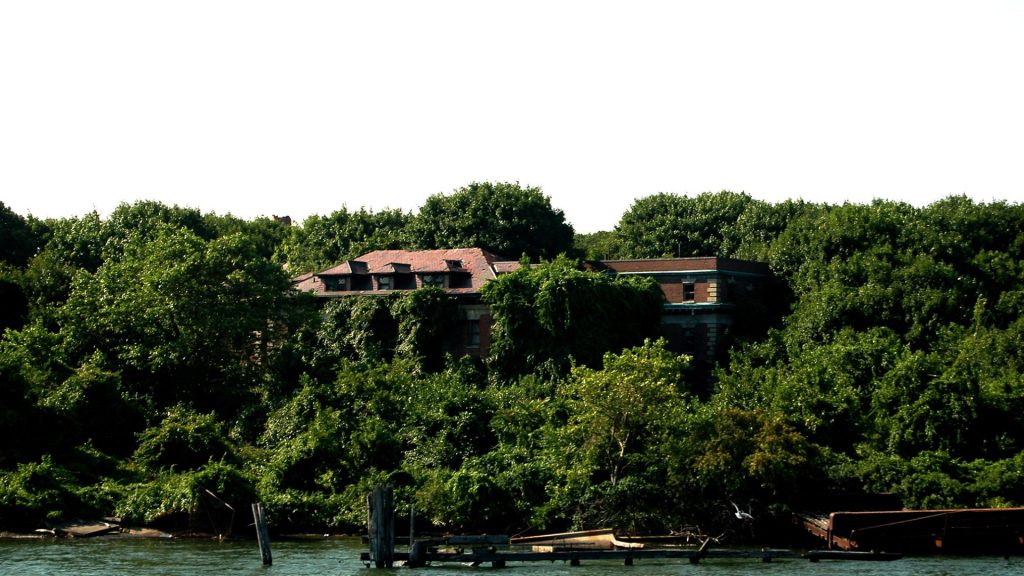
To explore the island, you’ll first need to secure permission and then arrange for a boat charter, which can be quite costly. Once you arrive, there’s no dock, so you’ll have to transfer to smaller boats and essentially beach yourself on the shore. While this may seem unconventional, it’s actually the most legitimate way to visit the island. However, it’s worth noting that access to the island is typically restricted to researchers, making it a rare privilege for visitors.
Movie Night Anyone?
The entertainment hall is a haunting sight. The theater seats, once filled with eager spectators, now lay in ruins, collapsed and broken. Yet, amidst the wreckage, the curtain runner stands defiantly, a testament to the resilience of this forgotten place. It’s hard to fathom the audience that once gathered here – typhoid and tuberculosis patients, recovering drug addicts, seeking solace and distraction from their harsh realities. The echoes of their laughter and applause still linger, trapped within the decaying walls.

Explorers have also noted that the light switches in the hall still flick up and down, emitting that nostalgic, clunky sound that we’ve mainly encountered in classic films.
Worlds Apart
From the Bronx, North Brother Island is deceptively close to the bustling city of New York. Surprisingly, this once thriving island has been left to decay, despite its potential for valuable real estate. It’s hard to fathom why no one has taken advantage of this prime location to create a desirable property.

The island’s proximity to the city, while still feeling isolated, has been compared to viewing Earth from the moon. This unique perspective highlights the seclusion experienced by those on the island. The patients, who were just a short distance away from their homes, must have felt a deep sense of frustration and longing. It’s no wonder that this situation could have contributed to their mental state.
A Home for Veterans
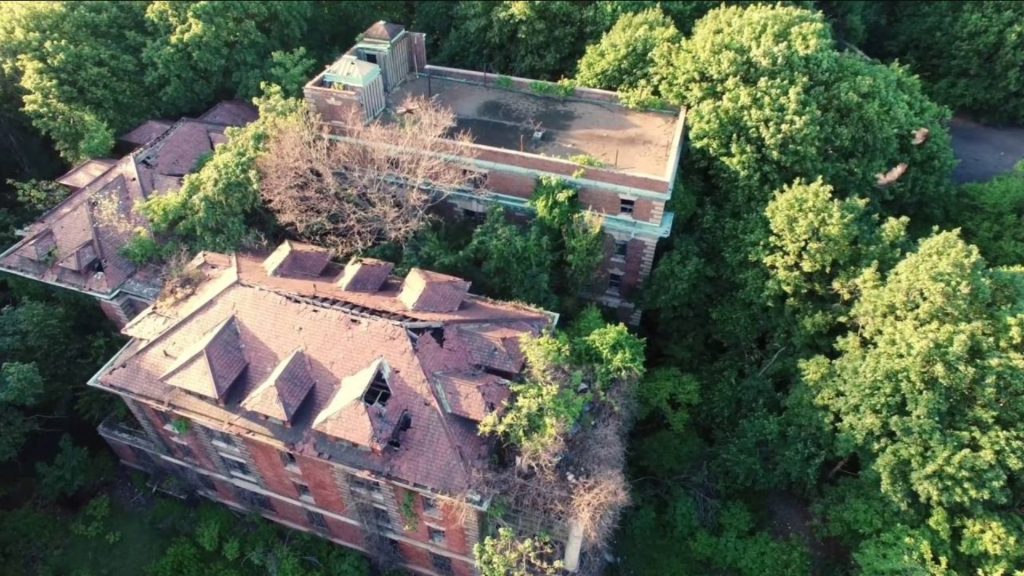
During World War II, Roosevelt Island served as temporary housing for military veterans and their families attending New York colleges. This unexpected turn of events reveals the island’s versatility and its ability to adapt to changing needs. While its history may be marred by rumors of patients being held against their will, this chapter sheds light on a different side of the island’s past. Unfortunately, as more housing options became available post-war, the island lost its appeal for veterans, leading to its abandonment once again.
The Lighthouse
North Brother Island remained relatively obscure until the 19th century. Historical records are scant, but it is believed that the island had no significant role until the construction of a lighthouse in 1869.

The journey to build this lighthouse began in 1829 and spanned four decades of negotiations before it was finally constructed on the island. A significant development occurred in 1883 when a fence was erected to separate the lighthouse from the Riverside Hospital. This further isolated the patients, cutting off any contact they had with the outside world. The lighthouse’s construction and subsequent isolation of the hospital patients created a unique and intriguing historical narrative.
Quarantine Islands: A Not-So-Unusual Practice
During its operational years, North Brother Island served as a quarantine site for individuals with contagious diseases. This practice was not uncommon during that time, and although the island is now abandoned, its history as a quarantine facility adds to its intriguing allure.
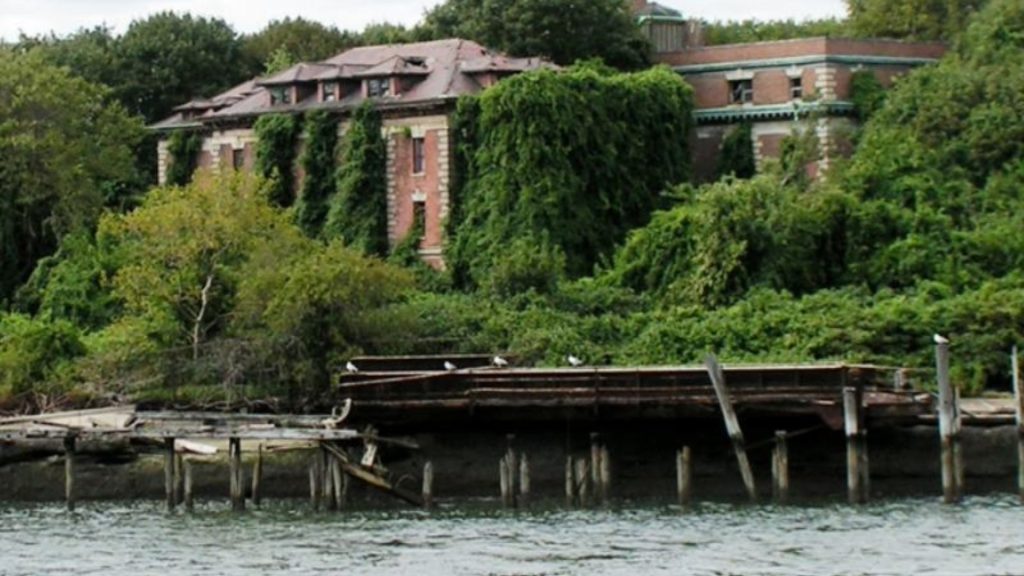
In cities like New York, islands were often used for social welfare purposes and to keep certain groups separate from the rest of society. This practice allowed for control and separation without complete isolation from the mainland. It was a convenient solution for managing interactions between different groups.
North Brother steals the spotlight on T.V.
With minimal human presence since the 1960’s, this island serves as a fascinating example of what would transpire if humans suddenly disappeared from the region. The lack of human impact has allowed nature to reclaim its territory, offering a glimpse into a world untouched by human influence. This unique scenario presents an opportunity to observe the potential consequences of our absence, as the island thrives in its natural state. It is a captivating reminder of the resilience and adaptability of the natural world.
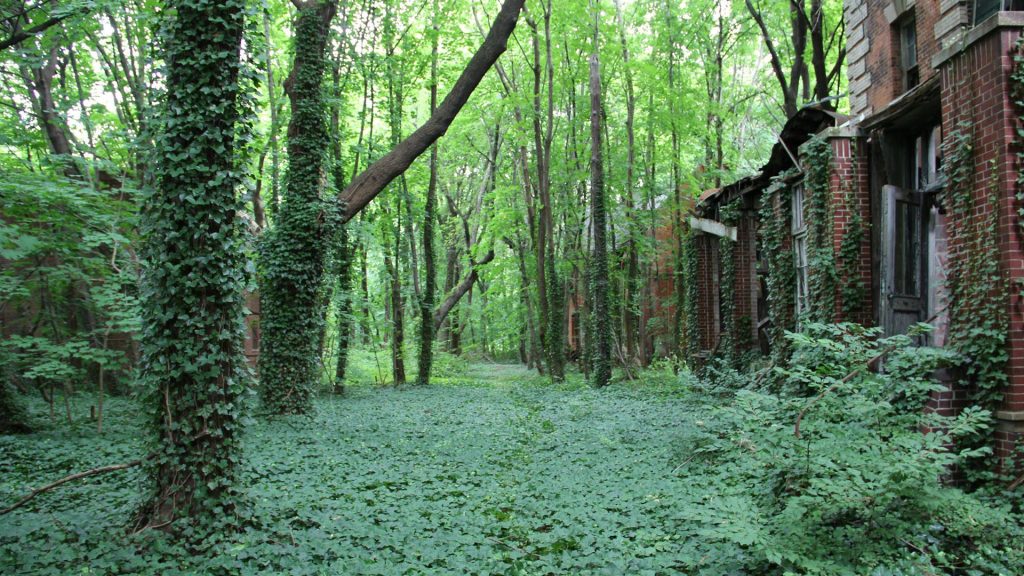
In 2009, the island made its television debut in the episode “Armed and Defenseless” of the series Life After People. This captivating episode offered viewers a glimpse into the fate of structures left untouched for 45 years. The island’s allure didn’t stop there, as it continued to make appearances in popular shows like Broad City and Unforgettable, solidifying its status as a sought-after location in both reality and fiction.
The Neglected Fate of North Brother Island: Why No Development Occurred
North Brother Island, with its picturesque appeal, seems like the perfect getaway for the elite. Surprisingly, the island remained undeveloped despite changing ownership in the 20th century. One key reason behind this is its unfortunate proximity to the bustling LaGuardia airport. The constant noise and disruption from the planes flying overhead deterred any potential investors from transforming this hidden gem into a luxurious summer retreat.

The proximity of this island to the airport means that planes fly low and directly overhead, making it less than ideal for those seeking a peaceful summer retreat.
Surviving the Island’s Challenges
In the isolated confines of North Brother Island, access to essential supplies became a precarious challenge. With no connection to the mainland except by boat, harsh weather conditions often disrupted the delivery of much-needed provisions. As a result, patients on the island were forced to endure not only their illnesses but also the torment of scarce food and other necessities. This added layer of hardship only intensified their already difficult existence on the island.
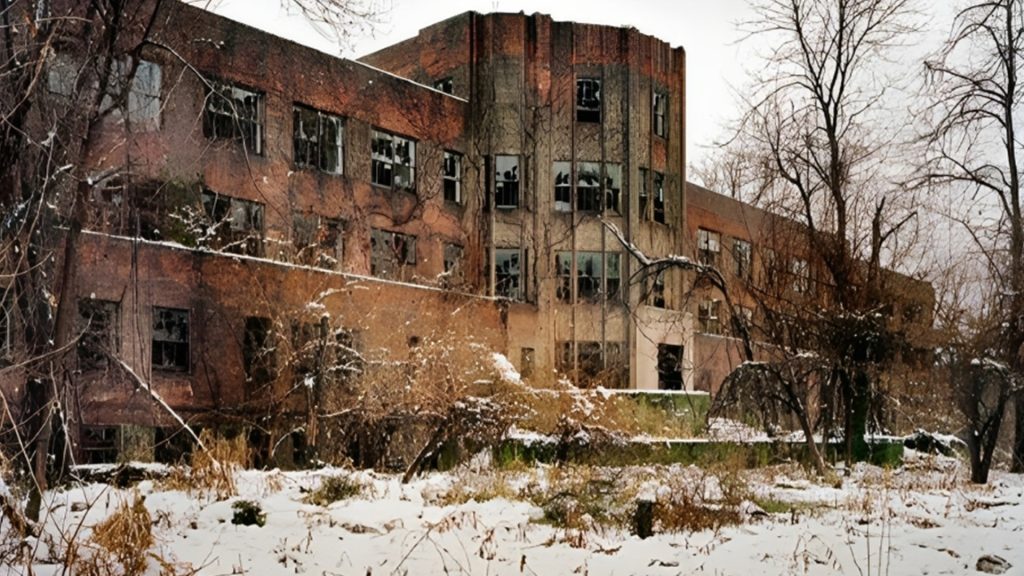
During the winter months on North Brother Island, the lack of insulation in the buildings made the conditions incredibly harsh. The cold would seep through the walls, leaving the inhabitants to endure brutal temperatures. The island’s reputation was so dire that being sent there was likened to a death sentence. Those who did manage to return compared their experience to the infamous “Black Hole of Calcutta,” a dark and oppressive prison known for its inhumane conditions.
Exploring 19th Century New York: A Glimpse into the Big Apple’s Past
In the 19th century, New York’s geography was a reflection of its socioeconomic divide. North Brother Island, for instance, served as a poignant symbol of this divide. It was on the outskirts of the city, along with other waterfronts and islands, where poorer communities were often relegated. This spatial arrangement not only highlights the stark disparities in wealth and privilege but also sheds light on the historical context of urban development in New York City.
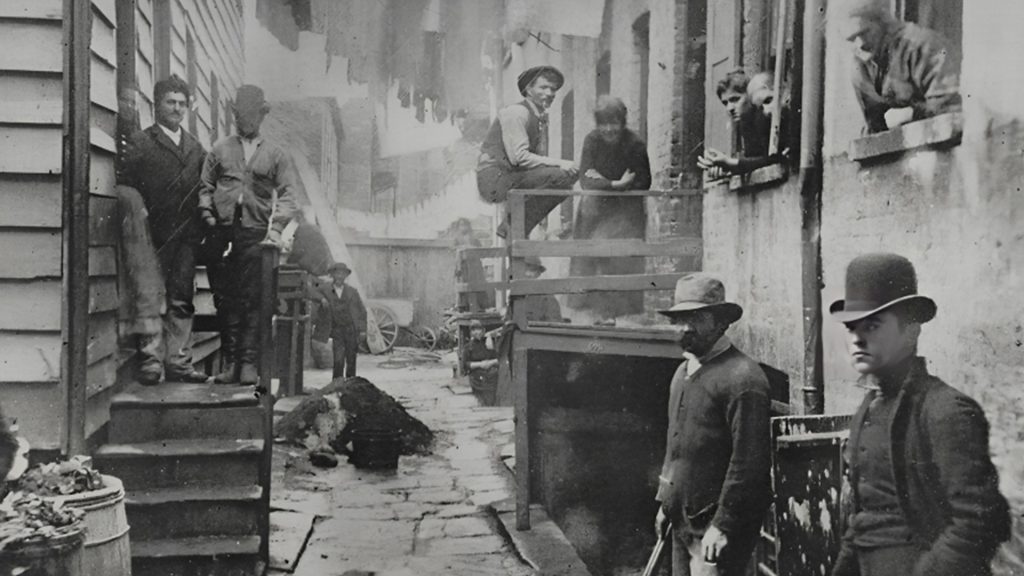
In a fascinating twist of fate, the geography and real estate of New York City have undergone a complete transformation since the 1800s. Once considered slums for the poor and undesirable, these neighborhoods have now become highly sought-after and exorbitantly priced locations. It’s truly remarkable how the tides have turned, with these areas now boasting some of the most expensive real estate in the entire country.
Unveiling the Haunting Phenomenon of North Brother
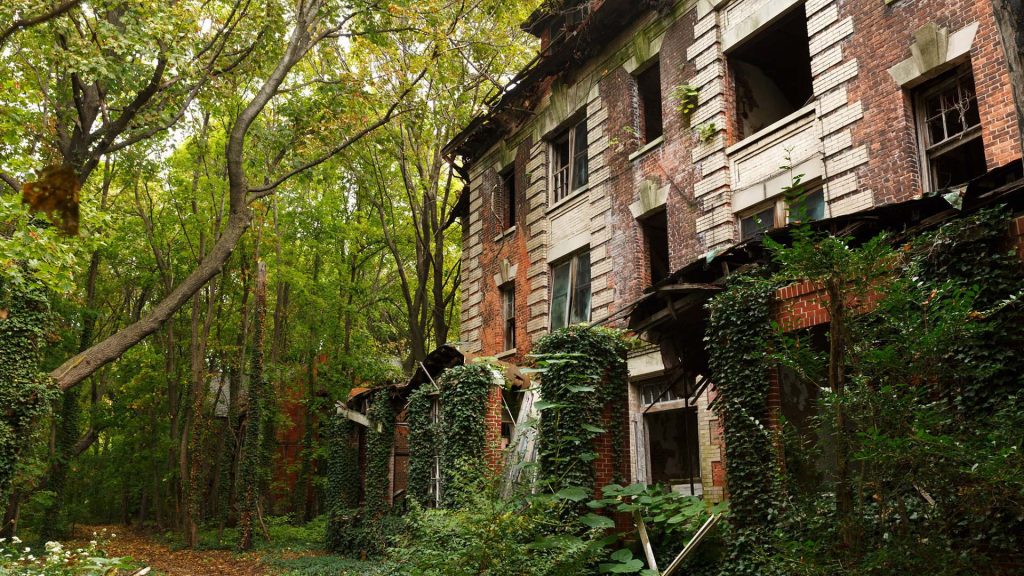
North Brother Island’s haunting history has given rise to chilling tales of supernatural occurrences. Eerie rumors of ghosts and paranormal activity swirl around the island, leaving no room for surprise. Visitors have reported spine-tingling experiences such as unexplained sounds echoing through the abandoned buildings, electronic equipment mysteriously malfunctioning, and the unsettling sensation of being touched or pulled by an unseen force. The island’s eerie aura is enough to send shivers down anyone’s spine.

